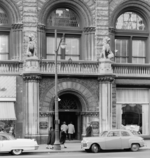Newark Tech High School
High schools in Newark, New JerseyPublic high schools in Essex County, New JerseyUse American English from October 2020Use mdy dates from October 2020Vocational schools in New Jersey
Newark Tech High School is a regional public high school located in Newark, that offers occupational and academic instruction for students in Essex County, in the U.S. state of New Jersey, serving students in ninth through twelfth grades as part of the Essex County Vocational Technical Schools. As of the 2021–22 school year, the school had an enrollment of 570 students and 54.0 classroom teachers (on an FTE basis), for a student–teacher ratio of 10.6:1. There were 395 students (69.3% of enrollment) eligible for free lunch and 56 (9.8% of students) eligible for reduced-cost lunch.Students are required to abide by the school's uniform / dress code policy.
Excerpt from the Wikipedia article Newark Tech High School (License: CC BY-SA 3.0, Authors).Newark Tech High School
Raymond Boulevard, Newark
Geographical coordinates (GPS) Address Nearby Places Show on map
Geographical coordinates (GPS)
| Latitude | Longitude |
|---|---|
| N 40.739794 ° | E -74.181867 ° |
Address
Essex County Technical Careers Center
Raymond Boulevard
07103 Newark
New Jersey, United States
Open on Google Maps





